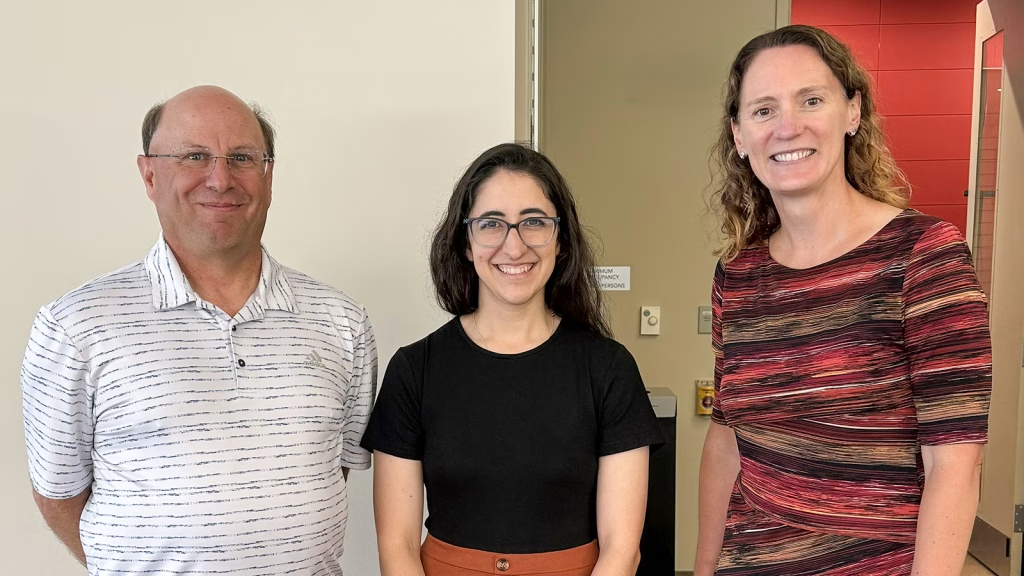Collagen is the most prevalent protein in the human body, keeping our joints healthy, our bones strong and our skin stretchy.
However, studies increasingly show that collagen in the extracellular matrix, the gelatinous material that surrounds our cells, also plays a key role in the spread of cancer (known as metastasis). And by better understanding the mechanics of how cancer cells move from the main tumor, researchers could pinpoint potential targets for cancer therapies to thwart the disease’s progression.
In a recent paper in the journal Acta Biomaterialia, University of Wisconsin-Madison biomedical engineers showed how the alignment of collagen fibers accelerates the movement of clusters of pancreatic cancer cells.
“We all know that the extracellular matrix is a really critical component of pancreatic cancer, and that’s why it’s challenging to treat and it’s very aggressive,” says Melissa Skala, a professor of biomedical engineering and investigator at the Morgridge Institute for Research on the UW-Madison campus.
By using a unique combination of microscopy imaging of real patient samples and fabrication techniques, researchers from the labs of Skala and Professor Paul Campagnola found that parallel-aligned collagen fibers acted as a highway for cancer cells. Beyond that, study lead author Sophie Mancha (PhDBME ’24) and collaborators discovered that the cells moved especially aggressively in clustered groups. Previous research has focused predominantly on single-cell movement, as opposed to collective cell migration.
“It adds credence that this collective cell migration is really important in pancreatic cancer,” says Campagnola.
Campagnola’s lab has pioneered the combination of using an imaging technique called second harmonic generation microscopy to view patient biopsies and then fabricating them to create realistic scaffolds for cell cultures.
“Our technology is really the only way to make true mimics of the collagen structure,” says Campagnola.
While analyzing cancer cell behavior across a range of patient-derived scaffolds, the group consulted Jacob Notbohm, an associate professor of mechanical engineering who studies collective cell movement. Grown on scaffolds that mimicked aligned collagen fibers, clustered cells displayed higher levels of traits associated with metastatic behavior than did single cells. The researchers also found that clusters grown on aligned scaffolds moved much more rapidly than groups grown on unpatterned surfaces, adding more evidence that collagen fibers provide a conduit for cancer cell spread.
The team already has another paper in the works examining the metabolic activity of multiple cancerous cell lines on the scaffolds. Moving forward, Skala and Campagnola are interested in using genetic sequencing to uncover which genes are at work in the cancer cells and in assessing chemotherapy agents on cell clusters to inform personalized medicine strategies.
Mancha, whose grandfather died from pancreatic cancer when she was in high school, got an immediate graduation present when the paper was accepted eight minutes after she finished her dissertation defense.
“This just continues to highlight that collagen is very important, and the reorganization of collagen is doing something,” says Mancha, who’s now in the scientific leadership development program at Tolmar, a pharmaceutical company based in Fort Collins, Colorado. “It’s important that we continue to study that and see if collagen could be a future therapeutic target for pancreatic cancer patients.”
Paul Campagnola is the Peter Tong Department Chair of Biomedical Engineering. Melissa Skala holds the Carol Skornicka Chair at the Morgridge Institute for Research. Other UW-Madison-affiliated authors include Kevin Eliceiri, a professor of biomedical engineering who holds the Retina Research Foundation Walter H. Helmerich Research Chair at the McPherson Eye Research Institute at UW-Madison; undergraduate researchers Meghan Horan (BSBME ’24) and Ojaswi Pasachhe; Adib Keikhosravi (PhDBME ’20); and Kristina A. Matkowskyj, a former professor in the Department of Pathology and Lab Medicine.
The research was supported by the National Institutes of Health (award R21 CA224280 and U54 CA268069), the Morgridge Institute for Research, and the National Science Foundation Graduate Research Fellowship Program.
Top photo: From left: Professor Paul Campagnola, recent PhD graduate Sophie Mancha and Professor Melissa Skala. Submitted photo.
